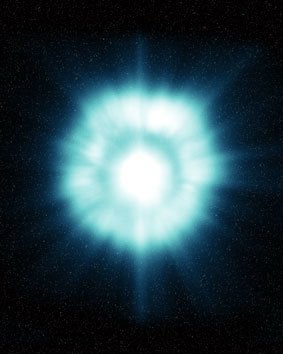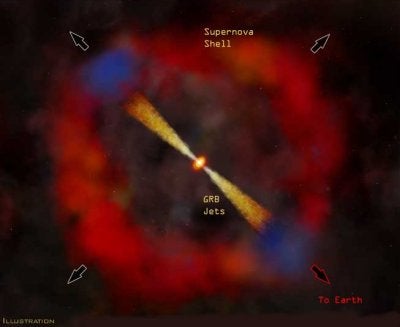April 2, 2003Andrew FazekasSupernova is ‘smoking gun’ in gamma-ray-burst whodunit

Astronomers think gamma-ray bursts may be linked to black holes but aren’t sure of the exact circumstances of their creation. One idea is that gamma-ray bursts are produced after a massive star explodes and leaves a black hole in its place. Another idea is that they’re produced when two neutron stars collide to form a black hole. The appearance of a gamma-ray burst is unpredictable, but one appears about once per day.ESA / ECFEvery day there is a gamma-ray burst somewhere in the depths of space. Shining with the intensity of a million trillion suns only to fade away within seconds, these brilliant flashes are the most violent and enigmatic phenomena in the universe. But a team of astronomers using NASA’s Chandra X-ray Observatory announced a breakthrough at last week’s meeting of the High Energy Division of the American Astronomical Society in Quebec, Canada. The researchers explained that they tracked the afterglow of a gamma-ray burst for more than 21 hours and uncovered clear signatures characteristic of supernova explosions there.
Comparable to a forensics investigation, a supernova explosion may be the proverbial smoking gun scientists have been looking for to understand the origins of gamma-ray bursts. According to the team leader, Nathaniel Butler from the Massachusetts Institute of Technology, “If a gamma-ray burst were a crime, then we now have strong circumstantial evidence that a supernova explosion was at the scene.”
Designated GRB 020813, the gamma-ray burst was first detected by the High Energy Transient Explorer 2 (HETE-2) on August 13, 2002. Following the initial, intense burst of gamma rays, Chandra quickly swung into action to observe the x-ray afterglow. The grating spectrometer aboard Chandra revealed the presence of a supernova hidden beneath the powerful glow of the gamma-ray burst. An overabundance of heavy elements were clearly identified in the spectrum of GRB 020813, a distinct fingerprint pointing to the death throws of massive star.

Some scientists suspect that the x-ray afterglow following a gamma-ray burst is produced when a jet of high-energy particles shooting from a black hole (itself the remnant of an exploded star) slams into the expanding supernova shell.CXC / M. Weiss“This is our first opportunity to see freshly minted material produced in supernova explosions” says University of Chicago co-investigator Donald Lamb. “Other times when we see supernova remnants, they have already been mixed a great deal with the interstellar medium.”
Some believe that when a black hole forms as result of a supernova, jets of high-energy particles radiate outward into space, causing the initial, brief burst of powerful gamma rays. Within hours this hot jet of particles collides with the cloud of ejected remains of the dead star and produces an x-ray afterglow that is glimpsed by x-ray telescopes in Earth orbit.
Likened to a race between the tortoise and hare, the remnants ejected from the supernova explosion is slow in expanding at only a tenth the speed of light, while the x-rays that illuminate it are moving at the absolute speed of light. If the tortoise and the hare started at the same time, the slower supernova material could never get in front of the x-rays. This material, therefore is suggested to have been expelled some time before — possibly as much as 60 days — so that when the x-rays come out of the burst they can catch up to them.
Donald Lamb added, “This race between the tortoise of the ejected material and the hare of the x-ray afterglow is a strong piece of evidence that there is a two-stage event happening and supports the theory of a time delay between the supernova and the gamma-ray burst.”
Andrew Fazekas is an astronomy columnist based in Montreal, Canada, who frequently writes for magazines, newspapers, and the Canadian Space Agency. He currently does science news commentary for both radio and television, teaches backyard astronomy at Vanier College, and is an editor at the American Association for the Advancement of Science.
Search for other articles by this author
Andrew Fazekas is an astronomy columnist based in Montreal, Canada, who frequently writes for magazines, newspapers, and the Canadian Space Agency. He currently does science news commentary for both radio and television, teaches backyard astronomy at Vanier College, and is an editor at the American Association for the Advancement of Science.





